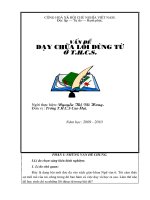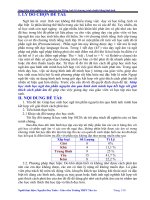Bài giảng Sáng kiến kinh nghiệm dạy từ vựng Tiếng Anh 12 chuẩn
Bạn đang xem bản rút gọn của tài liệu. Xem và tải ngay bản đầy đủ của tài liệu tại đây (420.36 KB, 19 trang )
Sáng kiến kinh nghiệm initiative experience
SỞ GIÁO DỤC - ĐÀO TẠO TRÀ VINH
TRƯỜNG THPT TÂN AN
GIÁO VIÊN: NGUYÊN DUY TUÂN
BỘ MÔN: NGOẠI NGỮ
TRƯỜNG THPT TÂN AN
TÊN ĐỀ TÀI: DẠY TỪ VỰNG TRONG PHỔ THÔNG TRUNG HỌC
ỨNG DỤNG: DẠY TRONG SÁCH GIÁO KHOA LỚP 12 CƠ BẢN
NĂM HỌC
2009-2010
Nguyen Duy Tuan – Tan An High School
1
1
Sáng kiến kinh nghiệm initiative experience
THE THEME
HOW TO TEACH VOCABULARIES IN HIGH
SCHOOL
FOCUS ON ENGLISH 12
TEACHER: NGUYEN DUY TUAN
SCHOOL: TAN AN HIGH SCHOOL
Nguyen Duy Tuan – Tan An High School
2
2
Sáng kiến kinh nghiệm initiative experience
PREFACE
Studies have shown that vocabulary knowledge is strongly correlated, and researchers have found
that word knowledge in high school can predict how well students will be able to comprehend
texts they read in high schools. Limited vocabularies prevent students from comprehending a text.
Direct instructions in vocabulary can help arrest this cycle. Good readers often acquire much of
their vocabulary through wide independent reading, also known as incidental learning. However,
explicit instructions can help students learn enough words to become better readers (and thus
acquire even more words). Direct vocabulary instructions are useful for students at all ability levels,
but it is particularly useful for beginning students who have a limited reading vocabulary and little
exposure to incidental vocabulary learning outside of schools.
Studies have shown that the key to increase vocabulary is exposure to new words—not an innate
ability to learn from context. Experts emphasize that vocabulary development is an attainable goal.
If given the opportunity to learn new words as well as effective instruction, most students can
acquire vocabulary at rates that will improve their comprehension. This enables them to read
increasingly challenging texts with fluency and betters their chances for success in school and
afterward.
These are some methods I have applied to teach in school which depends on each lesson and time.
In my initiative experience I focus on 4 main methods:
I. Showing the meaning of words visually
1. Using pictures
2. Using media
3. Using realia
4. Using mine
II. Showing the meaning of words in context
Using examples, situations, explanations
III. Using synonyms or antonyms
IV. Translation and Definition
V. Use exercises
1. Gap filling
2. Multiple choice
Nguyen Duy Tuan – Tan An High School
3
3
Sáng kiến kinh nghiệm initiative experience
I. SHOWING THE MEANING OF WORDS VISUALLY
1. USE PICTURES AND CARDS
Picture cues are a great mechanism for teaching young Students to study Vocabularies. They can
combination of words and visual cues can help a young mind piece together a word. There are
several ways to approach it. The approach shown here works with whole words. First, you can plan
your lesson and pick the words you'll teach your student. An effective way to do this is by
categories. For example, teach your student how to read words associated with fruit, such as apple,
orange or peach. Since the human mind likes to categorize things, this method helps these words gel
into your young student’s mind. Second, Get the corresponding picture cue cards. You can obtain
picture cue cards with one letter on them or with entire words on them. When teaching a student to
read by showing whole words, its best to look for picture cue cards that deal with life activities.
These packages normally have food groups and other categories in them. Third, Sit the child down
in a quiet place before starting the lesson. The trick to getting picture cues to work is to keep a
young student’s attention and have her connect a picture with a word. This won’t happen if she
can’t see the picture cue card or is distracted by sounds. Forth, Pick up a picture cue card and say
the corresponding word. Make sure you explain what you are doing before the lesson. Then, as you
say the word and show the picture cue card, allow a time delay. This time delay (1 to 3 seconds)
will allow your student to soak in the word and associate it with the image. After you show the
picture card, spell the word so your student will associate certain alphabetic letters with the image.
Next, Repeat this exercise at least two times. This means you should show a picture cue card of an
apple and say the word twice. Repetition is a proven method of learning, so use it to your
advantage. Then, coordinate picture cues with spelling lessons. You can do this by covering up the
word on the picture cue card and revealing only one letter at a time as the student says it to you.
This will further associate the word with the picture and help the young student learn to read. Last
but not least, Allow your student a chance to show off his stuff. After you’ve been working with
your student for a while, mix up the order of your picture cue cards and allow him to read the words
back to you. This will let you see if he is really learning or if he has just memorized the order of the
picture cue cards.
These are one activity which helps Ss guess the meaning vocabularies which is related to the lesson
ILLUSTRATED LECTURE
Nguyen Duy Tuan – Tan An High School
4
4
Sáng kiến kinh nghiệm initiative experience
unit 9: Deserts Speaking ( page 99)
Choose the right words or phrases which best describe the pictures.
CARDS:
A B
C
D
E F
G H
I J
Nguyen Duy Tuan – Tan An High School
5
5
Eucalyptus
desert
Dessert
Grass
Date palm
Crocodile
Camel
Fox
Lizard
Frog
Sáng kiến kinh nghiệm initiative experience
PICTURES:
P1. P2. P3. P4. P5.
P6. P7. P8. P9. P10
Students’activies
Ss is devided two groups, and they have to observe pictures carefully and use cards to paste in the
pictures
The class will be vibrant
Teacher’s activities
T devides the class into 2 groups
T asks Ss to paste pictures which are suitables with cards
T helps Ss to discuss
T gives small presents or add mark for the winning group
T helps to read
Suggested answers
A. Eucalyptus /,ju:kə'liptəs/ P9
B. desert/de'zə:t/ P10
C. Dessert /di'zə:t/ P3
Nguyen Duy Tuan – Tan An High School
6
6
Sáng kiến kinh nghiệm initiative experience
D.
Grass /grɑ:s/
P7
E.
Date palm /'deitpɑ:m/
P8
F.
Frog /frɔg/
P4
G.
Crocodile 'krɔkədail
P1
H. Camel /'kæməl/ P5
I.
Fox/fɔks/
P4
J. Lizard /'lizəd/ P2
2. USING MEDIA ( USING VIDEO)
Almost any video can be used to teach English: commercial films, TV programmers, home-made
dramas and holiday films. Live television programmers are NOT recommended. Your method
should vary according to the language point you wish to teach and the level of your student(s)
Although a handset is ideal, it is not essential. Position yourself near the front of the class, to one
side - close enough to the video player to work the controls if you do not have a handset. If the
video player is independent of the TV, turn it so you can work the controls easily without interfering
with your students' view of the TV screen. This medium can be used to pratise consolidate range
of language points to introduce subject(s) for debate to encourage conversation amongst students to
improve writing skills to introduce new vocabulary to develop listening skills (with visual aid) Few
lessons would involve continuous viewing - even with speech-free films. Strategic stopping is
essential. The teacher controls what students see and hear: Films, with excessive bad language, can
be shown without sound If the majority of film is good, unsuitable sex or violent scenes can easily
be avoided as follows plan in advance how to exploit the remainder of the film knowing the exact
counter positions of scenes to be omitted
ILLUSTRATED LECTURE
Unit 2: Cultural diversity _ Listening ( page 24)
Nguyen Duy Tuan – Tan An High School
7
7









